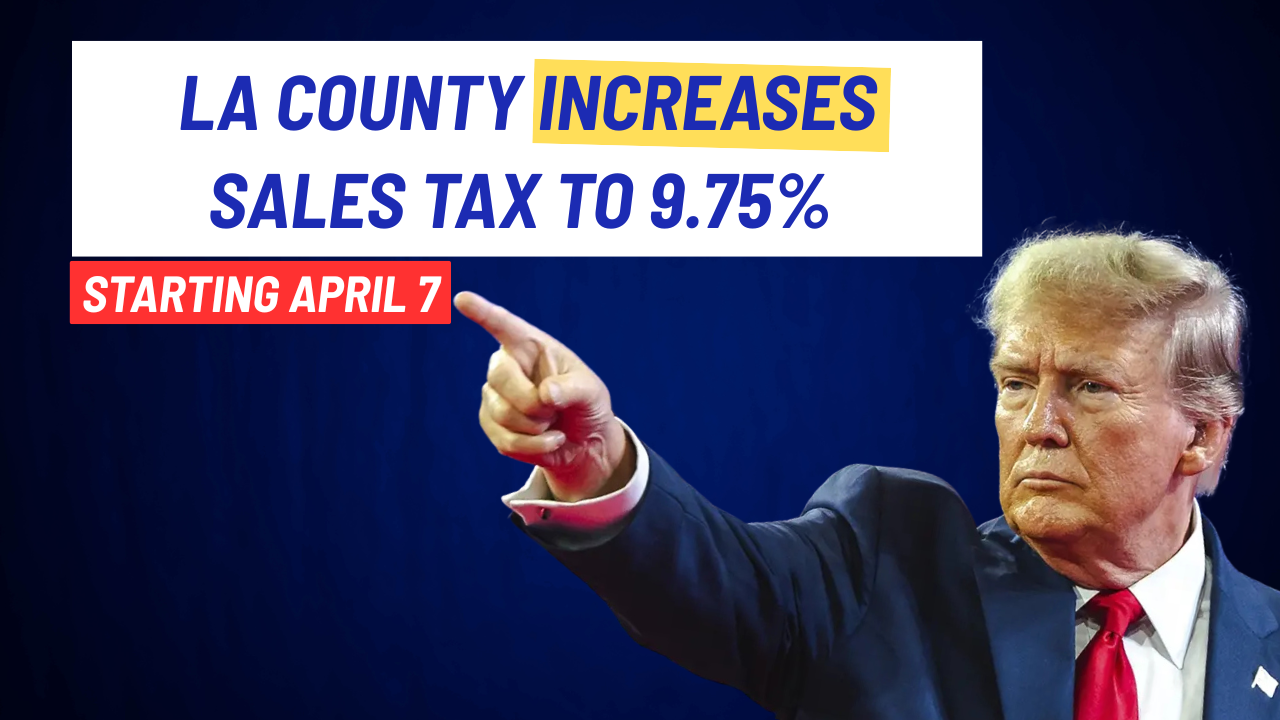LA County Increases Sales Tax to 9.75% Starting April 7
Shoppers across Los Angeles County woke up to higher prices today, as a new sales tax rate of 9.75% officially took effect. This increase stems from Measure A, a voter-approved initiative designed to address the county’s worsening homelessness crisis. While some residents may only notice a few extra cents on their receipts, for others—especially business owners and frequent shoppers—the impact could add up quickly.
What Is Measure A and Why Was It Passed?
Measure A, officially known as the Affordable Housing, Homelessness Solutions and Prevention Now measure, replaces the previous Measure H, a quarter-cent sales tax passed in 2017 that was set to expire in 2027. Measure A raises that tax to a half-cent, effectively increasing the base countywide sales tax rate.
Key Goals of Measure A:
- Fund permanent housing solutions for homeless individuals
- Expand mental health and substance abuse treatment
- Support affordable housing construction
- Prevent at-risk individuals from falling into homelessness
- Improve tracking and accountability in homelessness programs
The measure was approved by voters in November 2024 and took effect April 7, 2025. It will remain in place indefinitely unless repealed by voters in the future.
How Much More Will You Pay?
In unincorporated areas and cities without their own additional tax measures, the rate rose from 9.5% to 9.75%. For every $100 spent, you’ll now pay 75 cents in sales tax instead of 50 cents.
However, many cities within Los Angeles County already had local sales tax rates above the base level. As a result, the actual tax rate in some areas is much higher than 9.75%.
Examples of New Sales Tax Rates:
| City | Previous Rate | New Rate (April 7) |
| Palmdale | 10.25% | 11.25% |
| Lancaster | 10.25% | 11.25% |
| Artesia | 9.5% | 10.50% |
| Downey | 10.00% | 10.50% |
| South Gate | 10.25% | 10.75% |
| Santa Monica | 10.25% | 10.75% |
| Long Beach | 10.25% | 10.50% |
| Glendale | 10.25% | 10.50% |
| Manhattan Beach | 9.5% | 10.25% |
Some of these changes include local voter-approved tax hikes added on top of Measure A, pushing sales taxes in certain cities to levels above 11%—among the highest in the nation.
Which Purchases Are Affected?
Most everyday purchases are subject to sales tax, including:
- Electronics
- Furniture
- Clothing
- Household items
- Gasoline
- Cars
What’s Not Taxed?
According to the California Tax Service Center, some items are exempt, such as:
- Groceries for home consumption
- Prescription medications
- Medical devices
- Purchases made using EBT cards
- Sales to the U.S. government
How Will the New Tax Revenue Be Spent?
Los Angeles County expects to collect over $1 billion annually from the new tax. According to the county’s Homeless Initiative, here’s how the money will be used:
Allocation Breakdown:
- 60% for homeless services:
- Mental health and addiction programs
- Emergency shelters
- Case management services
- 15% of the homeless services fund will be distributed to cities and regions based on the unhoused population in each area
- 40% for housing production:
- 35.75% goes to the Los Angeles County Affordable Housing Solutions Agency
- 3% to the LA County Development Authority
- 1.25% to research and accountability programs
An innovation fund (1.65%) will also be created to test new approaches to reducing homelessness.
How Are Residents Reacting?
The public response is mixed. Some support the initiative, recognizing the urgent need to reduce homelessness in the region. Others are concerned about how the increased tax will affect their wallets—especially in an already expensive county.
Business Owner Perspective:
Saida Castro, owner of Cake & Coffee House in South Gate, shared:
“I have to think about the supplies and everything that’s going to cost more. If I increase prices for my customers, they’re going to feel it.”
Shoppers Feel the Pinch:
Luz Dayana Venegas, a South L.A. resident, said:
“Prices keep going up. We’re making tough decisions—like eating at home more and cutting extras.”
Will the Sales Tax Increase Solve Homelessness?
Supporters of Measure A argue that the money will provide the long-term investment needed to move people out of encampments and into stable housing. The Los Angeles County Board of Supervisors recently allocated:
- $656 million from Measure A
- $209 million in leftover Measure H funds
- $42.6 million in state grants
These funds will go toward consolidating and improving how homelessness services are delivered, including proposals to shift more control from LAHSA (Los Angeles Homeless Services Authority) directly to the county.
Progress Already Seen
According to LAHSA, early 2025 data shows:
- 5% to 10% decrease in unsheltered homelessness across the county
- The agency believes the region is “on track” to significantly reduce homelessness in the next year
How Does LA County Compare to Other Regions?
Here’s how LA’s new rates stack up:
| County | General Sales Tax Rate |
| Los Angeles County (base) | 9.75% |
| Palmdale/Lancaster | 11.25% |
| Orange County | 7.75% |
| Riverside County | 7.75% |
| Ventura County | 7.25% |
With some cities reaching 11.25%, Los Angeles now has some of the highest local tax rates in the United States.
What’s Next?
The new sales tax is permanent—unless voters decide to repeal Measure A in a future election. Meanwhile, county officials say they will:
- Monitor homelessness data
- Provide annual progress reports
- Fund affordable housing projects at scale
- Audit spending to ensure transparency
Final Thoughts
The new 9.75% base sales tax in LA County marks a major financial shift aimed at tackling one of the region’s most pressing challenges: homelessness. While small daily purchases may only increase by a few cents, the bigger question remains—will this funding actually make a measurable impact?
For now, both residents and business owners are adjusting. But all eyes are on the data, and whether this bold, permanent tax measure will bring real, visible change to the streets of Los Angeles.







